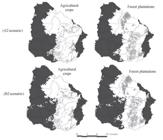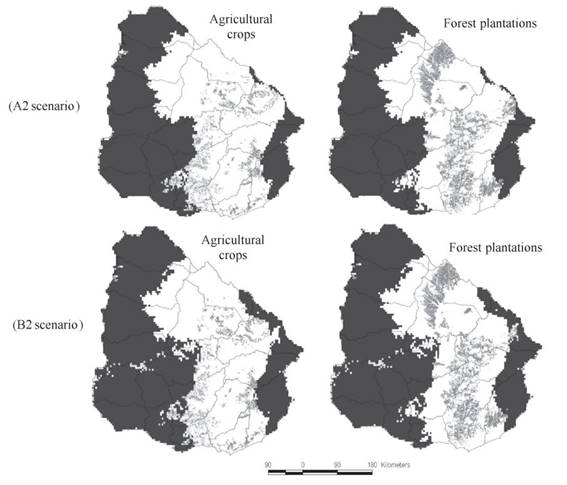ABSTRACT
Amphibians are the most threatened vertebrate group according to the IUCN. Land-use and land cover change (LULCC) and climate change (CC) are two of the main factors related to declining amphibian populations. Given the vulnerability of threatened and rare species, the study of their response to these impacts is a conservation priority. The aim of this work was to analyze the combined impact of LULCC and CC on the regionally endemic species Melanophryniscus sanmartini Klappenbach, 1968. This species is currently categorized as near threatened by the IUCN, and previous studies suggest negative effects of projected changes in climate. Using maximum entropy methods we modeled the effects of CC on the current and mid-century distribution of M. sanmartini under two IPCC scenarios - A2 (severe) and B2 (moderate). The effects of LULCC were studied by superimposing the potential distribution with current land use, while future distribution models were evaluated under the scenario of maximum expansion of soybean and afforestation in Uruguay. The results suggest that M. sanmartini is distributed in eastern Uruguay and the south of Brazil, mainly related to hilly and grasslands systems. Currently more than 10% of this species' distribution is superimposed by agricultural crops and exotic forest plantations. Contrasting with a recent modelling study our models suggest an expansion of the distribution of M. sanmartini by mid-century under both climate scenarios. However, despite the rise in climatically suitable areas for the species in the future, LULCC projections indicate that the proportion of modified habitats will occupy up to 25% of the distribution of M. sanmartini. Future change in climate conditions could represent an opportunity for M. sanmartini, but management measures are needed to mitigate the effects of habitat modification in order to ensure its survival and allow the eventual expansion of its distribution.
KEYWORDS
Species distribution modeling; global change; conservation; threatened species

 Thumbnail
Thumbnail
 Thumbnail
Thumbnail
 Thumbnail
Thumbnail
 Thumbnail
Thumbnail




